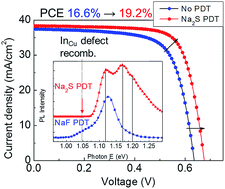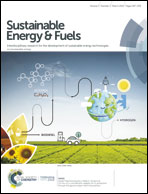Surface passivation and point defect control in Cu(In,Ga)Se2 films with a Na2S post deposition treatment for higher than 19% CIGS cell performance
Abstract
Na2S as a new alkaline source was employed to passivate the surface of a CIGS film. Na2S has less formation enthalpy compared with alkali fluoride compounds, leading to more effective dissolution at the surface. An efficiency of 19.2% was obtained by post deposition treatment (PDT) with Na2S as a source for cells with anti-reflective coating and an active area of 0.43 cm2. The remarkable performance enhancement compared to the efficiency of 16.64% of the cell without the PDT was due to the increase in Voc and FF. With the Na2S PDT, Na distribution in the CIGS film was much shallower and the valence band lowering was smaller compared to those with NaF PDT. Emission intensity of low-temperature photoluminescence at 1.04 eV, which corresponds to electron transition from In-in-Cu (InCu) antisite to the valence band maximum, was greatly reduced by Na2S PDT compared to NaF PDT. These results suggest that in addition to lowering the Cu vacancy concentration, the concentration of InCu defects significantly decreased at the CIGS surface using Na2S PDT compared with NaF PDT. Our results indicated that the surface passivation by Na2S PDT was more effective than by NaF PDT.



 Please wait while we load your content...
Please wait while we load your content...